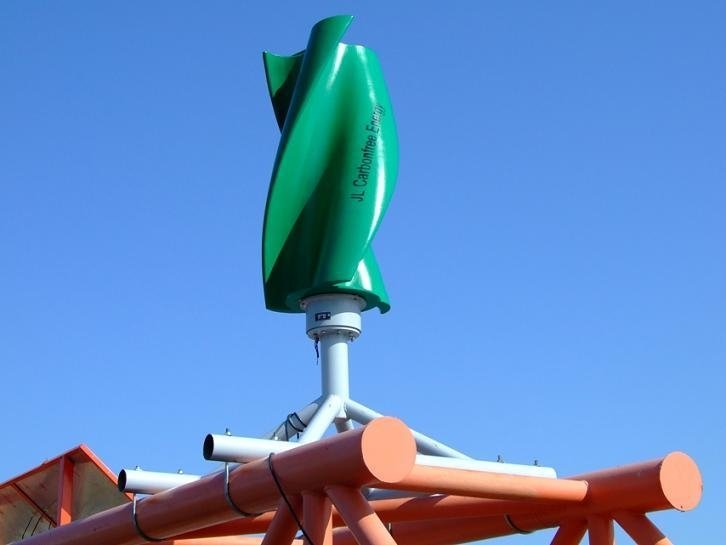Vertical axis wind turbines can
offer cheaper electricity for urban and suburban areas
American Institute of Physics
 EDITOR'S NOTE: Under Charlestown's draconian regulations against wind energy, even these types of wind energy generators are illegal unless the property owner goes through an astoundingly complex and expensive permitting process. CLICK HERE for more details. - Will Collette
EDITOR'S NOTE: Under Charlestown's draconian regulations against wind energy, even these types of wind energy generators are illegal unless the property owner goes through an astoundingly complex and expensive permitting process. CLICK HERE for more details. - Will ColletteSmall vertical axis wind turbines (VAWTs) possess the ability to effectively operate in the presence of high turbulent flow, which makes them ideal energy harvesting devices in urban and suburban environments.
In a new article, researchers present results indicating that an optimally designed VAWT system can financially compete with fossil-fuel based power plants in urban and suburban areas, and even spearhead the development of a net-zero energy building or city.
According to a prediction made by the U.S. Department of Energy,
wind energy could provide 20 percent of electricity in the U.S. by the year
2030.
This has motivated researchers from the University of Utah's Department of Mechanical Engineering to investigate the performance capabilities and financial benefits of vertical axis wind turbines (VAWTs) in urban and suburban areas.
A VAWT is a wind turbine design where the generator is
vertically oriented in the tower, rather than sitting horizontally on top.
While there are many VAWT designs, the one used in this study is called the
straight-blade Darrieus type or H-rotor turbine.
According to the researchers, small VAWTs possess the ability to
effectively operate in the presence of high turbulent flow, which makes them
ideal energy harvesting devices in urban and suburban environments.
In an article in this week's Journal of Renewable and
Sustainable Energy, from AIP Publishing, the authors present results
indicating that an optimally designed VAWT system can financially compete with
fossil-fuel based power plants in urban and suburban areas, and even spearhead
the development of a net-zero energy building or city.
To establish their results, the team input actual, time-resolved
wind speed data into a numerical simulation that determined the total amount of
energy captured by a turbine over a year of operation.
Their wind data was accrued over the year 2009 from 3-D sonic anemometers mounted on the top of traffic posts, about 9 meters, or 30 feet, above ground, and positioned at nine different urban and suburban sites around Oklahoma City, Oklahoma.
The researchers simulated 13 different wind turbine configurations,
with a focus on four particular design parameters: height-to-diameter aspect
ratio (H/D), blade airfoil shape, turbine solidity and turbine moment of
inertia.
The main performance measure used to identify the optimum design configuration was the percent of energy captured by the turbine over the course of the year relative to the available energy in the turbulent wind during the same time period.
The main performance measure used to identify the optimum design configuration was the percent of energy captured by the turbine over the course of the year relative to the available energy in the turbulent wind during the same time period.
Of the 13 design configurations, the optimal turbine design had
the lowest moment of inertia.
Interestingly, however, the researchers confirmed that even with the moment of inertia eliminated as a design parameter, this configuration was still the most ideal.
Interestingly, however, the researchers confirmed that even with the moment of inertia eliminated as a design parameter, this configuration was still the most ideal.
They also analyzed the various turbine designs for the levelized
cost of energy (LCOE) at one of the test sites and found the values for blade
characteristics necessary for economically viable options. The optimal design
configuration at this site produced electricity at a cost 10 percent lower than
the average national electricity unit price.
"This is not the end of our research, and I think that we
have more to study on the turbine design configuration and its operating
conditions that would allow for enhancing the amount of energy captured by the
turbine. [...] It's exciting," said Lam Nguyen, one of the lead
researchers on the project. Nguyen is currently expanding his research with a
former advisor.
Following their conclusion that an optimal design configuration
for VAWTs could lead to a lower electric cost, the team knows the work is not
finished.